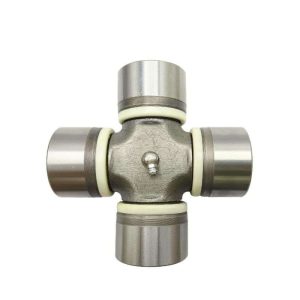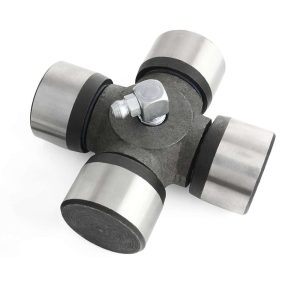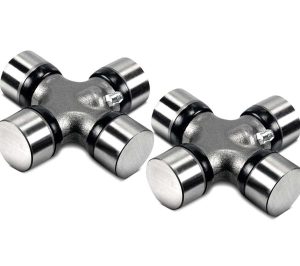Universal Joints
Table of Contents
Definition
A universal joint (U-joint) is a mechanical device that transfers rotary motion between misaligned shafts by flexing and rotating. It’s used in vehicles and machinery to maintain a connection between non-aligned shafts, allowing for the transmission of power or torque.

FHD Bearings is an ISO 9001:2015 certified manufacturing enterprise that stocks a full range of universal joint,thin section bearings,deep groove ball bearings, angular contact ball bearings, thrust ball bearings, Self-aligning ball bearings and ceramic ball bearings. With over 1,200 different bearing sizes and over 250K bearings in stock.
Materials
Steel
– Steel is a widely used material due to its strength and durability. It is often employed in heavy-duty and industrial applications.
Stainless Steel
– Stainless steel universal joints are preferred in environments where corrosion resistance and hygiene are essential, such as in food processing or medical equipment.
Cast Iron
– Cast iron is used in some applications, particularly where strength and cost-effectiveness are priorities.
Aluminum
Aluminum universal joints are used in lighter-duty applications where weight reduction is important, such as in some automotive and aerospace applications.

Alloy Steel
– Alloy steel is used for high-performance and specialty applications, offering improved strength and wear resistance.
Brass
Brass is used in situations where corrosion resistance is a priority, such as marine applications.
Features

- Continuous Motion Transmission:They provide a continuous mechanical connection between shafts, ensuring the transfer of rotary motion, power, or torque.
- Compact Design: Universal joints have a relatively compact and space-efficient design, making them suitable for applications with limited space.
- Simple Construction: Universal joints are typically simple in construction, consisting of a cross-shaped or yoke-shaped assembly with bearings at the intersection points.
- Cross Style: Universal joints can come in different cross styles, such as plain, needle-bearing, or sealed, each affecting factors like load capacity and maintenance requirements.
- Different Types: There are various types of universal joints, such as single U-joints, double U-joints, and constant velocity (CV) joints, each with specific characteristics suitable for different applications.
- Versatility: They come in various sizes and configurations to suit different applications and requirements, from automotive drivetrains to industrial machinery.
Advantages
- Angular Flexibility: Universal joints can accommodate angular misalignment between connected shafts, allowing them to transmit motion even when the shafts are not perfectly aligned.
- Durability: Universal joints are designed to withstand the stresses and loads associated with their intended applications, ensuring long-term durability.
- Low Maintenance: When properly lubricated, universal joints require minimal maintenance, contributing to their reliability.
- Broad Application Range: They are used in a wide range of applications, including automotive, agricultural machinery, industrial equipment, and more.
- Load Capacity: Universal joints are designed to handle a range of loads, from light-duty to heavy-duty applications, and are available in different load capacity ratings to match specific requirements.

Taxonomy
Universal Joint Cross Bearing

Universal Joint Cross Bearing
The universal joint is a flexible joint which allows the propeller shaft to transmit torque from the gearbox at an angle.
Applications

- Automotive Drivetrains: Cross bearings are commonly found in the universal joints used in vehicles, especially in the driveshaft and axle shaft assemblies.
- Agricultural Equipment: Many types of farming machinery, such as tractors and combine harvesters.
- Marine Applications: In boats and ships, universal joint cross bearings are used to connect the engine to the propeller shaft, accommodating the movement caused by waves and the flexible mounting of the engine.
- Heavy Equipment: Cross bearings are found in various heavy equipment like mining machinery, forestry equipment, and earth-moving vehicles, allowing the transmission of power and motion between non-aligned components.
- Industrial Robotics: Robotic arms and other automation equipment often incorporate universal joints with cross bearings to enable precise and flexible movement.
Key Manufacturing Process of Universal Joints
Raw Material Selection
The process begins with the selection of appropriate raw materials, usually high-quality steel or alloy steel, based on the intended application and load requirements.
Forging
The selected material is heated and forged into the rough shape of the universal joint cross. Forging provides strength and ensures the material is free from defects.
Heat Treatment
The forged blank is subjected to heat treatment processes such as quenching and tempering to enhance the material’s mechanical properties, including hardness and strength.
Machining
Precision machining is a crucial step where the rough blank is turned and milled to achieve the desired dimensions and tolerances. This includes creating the bearing journal surfaces, bores, and other critical features.
Drilling
Holes are drilled into the cross for the installation of needle bearings and grease fittings.
Grinding
Precision grinding is used to ensure smooth and precise surfaces on bearing journals, ensuring a proper fit with needle bearings.
Needle Bearing Installation
Needle bearings are assembled into the bearing journals to facilitate smooth rotation within the universal joint.


FAQ - Frequently Asked Questions

A universal joint cross bearing is a key component of a universal joint (U-joint), responsible for allowing the joint to transmit rotary motion between misaligned shafts.
Universal joint cross bearings are used in various applications, including automotive drivetrains, industrial machinery, agricultural equipment, marine applications, and aerospace.
Common materials include steel, alloy steel, aluminum, and stainless steel, chosen based on factors such as load capacity and environmental conditions.
They are typically forged, heat-treated, machined, drilled, ground, and assembled, with quality control and testing at each stage.
They accommodate misalignment, transmit motion efficiently, and are durable and versatile.
Commonly, grease is used to lubricate the needle bearings within the cross.
Regular lubrication and periodic inspection for signs of wear and damage are essential for maintenance.
Service life is influenced by factors such as load, operating speed, maintenance, and environmental conditions.
In most cases, individual universal joint cross bearings can be replaced without replacing the entire U-joint.
Symptoms include vibration, noise, and a feeling of looseness in the drivetrain.
By inspecting for visual wear, performing a driveline angle check, and listening for unusual sounds during operation.
Steps typically involve removing the driveshaft, disassembling the U-joint, pressing out the old cross bearing, and installing a new one.
Yes, they should be regularly greased according to the manufacturer’s recommendations, often during routine maintenance.
Yes, there are different types, including plain, needle-bearing, and sealed. Selection depends on factors like load capacity and maintenance requirements.
Lifespan varies depending on factors like load, maintenance, and environmental conditions but can range from tens of thousands to hundreds of thousands of miles or hours.
Typically, they need to be replaced when damaged or worn beyond acceptable tolerances.
Needle bearings reduce friction and allow for smooth and efficient rotation of the bearing journals within the cross.
Yes, manufacturers can provide custom solutions based on specific application requirements.
Common failure modes include wear, brinelling (indentations on the bearing surface), and loss of lubrication.
Regular lubrication, alignment checks, and early detection of issues can help extend the life of universal joint cross bearings, as can following the manufacturer’s maintenance guidelines.
Installation and Maintenance of Universal Joints
Installation
- Align the Shaft Ends: Position the shafts to be connected, ensuring they are properly aligned. Misalignment can lead to premature wear and reduced efficiency.
- Measure the Angle: Determine the angle between the shafts. This angle is crucial for selecting the appropriate universal joint.
- Assemble the Universal Joint: Attach the universal joint to both shafts, securing them with appropriate fasteners, ensuring a snug fit.
- Lubrication: Apply the recommended lubricant to the joint’s bearings. Lubrication is essential to reduce friction and heat generation.
- Torque Fasteners: Tighten the fasteners to the manufacturer’s specified torque settings to avoid overloading the joint.
- Test for Smooth Operation: Rotate the connected shafts by hand to ensure the universal joint operates smoothly and without binding.
- Final Inspection: Conduct a final inspection for any misalignment, unusual noise, or visible issues. Address any problems before operation.
Maintenance:
- Regular Inspection: Conduct routine visual inspections to check for signs of wear, damage, or misalignment. Look for unusual noise, vibration, or visible issues.
- Lubrication: Apply the recommended lubricant to the universal joint’s bearings at specified intervals. Proper lubrication reduces friction and heat, extending the joint’s life.
- Replacement of Worn Parts: If you identify any damaged or worn components during inspections, replace them promptly to prevent further damage to the machinery.
- Torque Verification: Periodically check and verify the torque settings of fasteners. Proper torque ensures the joint operates within its designed capacity.
- Alignment Check: Ensure that the shafts connected by the universal joint remain properly aligned. Misalignment can lead to increased stress and wear.
- Balancing: For applications with high rotational speeds, balance the universal joint to prevent vibration and extend its service life.
- Follow Manufacturer Guidelines: Always adhere to the manufacturer’s recommendations for maintenance intervals, lubricants, and procedures specific to the type of universal joint in use.

Related Posts
Universal Joint Bearings Materials and Designs:The Art of Extreme Durability
Categories Universal Joint Bearings Materials and Designs:The Art of Extreme...
Read MoreThe Symphony of Silence: Innovations in Noise Reduction for Universal Joint Cross Bearings
Categories The Symphony of Silence: Innovations in Noise Reduction for...
Read MoreBoosting Reliability: Universal Joint Cross Bearings
Categories Boosting Reliability: Universal Joint Cross Bearings Table of Contents...
Read MoreVersatility Unleashed: The Power of Universal Joint Cross Bearings
Versatility Unleashed: The Power of Universal Joints Table of Contents...
Read More



